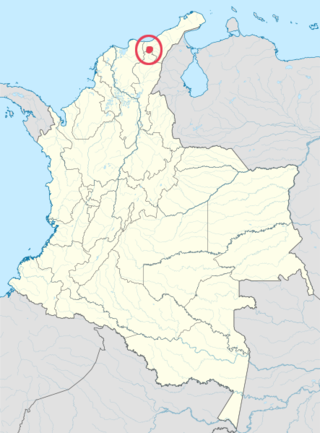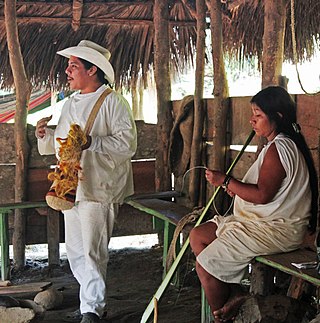Wiwa people
Indigenous Colombian ethnic group From Wikipedia, the free encyclopedia
The Wiwa people, also known as the Damana people,[2] are an Indigenous people of Colombia that speak Dʉmʉna, of the Chibchan language family, and live in the Sierra Nevada de Santa Marta region.[3][4]
 Indigenous Wiwa people in the Sierra Nevada de Santa Marta | |
| Total population | |
|---|---|
| 18,202 [1] (2018, census) | |
| Regions with significant populations | |
| Sierra Nevada de Santa Marta, Cesar Department, La Guajira Department, Valledupar, Santa Marta | |
| Languages | |
| Dʉmʉna, Colombian Spanish, Kagaba | |
| Religion | |
| Shamanism | |
| Related ethnic groups | |
| Arhuaco, Kogi, Kankuamo |
Etymology
The word Wiwa comes from the Dʉmʉna language, wi meaning warm or warm area and wa meaning people, combined to mean people of warm land. This refers to the Wiwa's historic inhabitance in the lower, warmer parts of the Sierra Nevada mountains.[5] The Wiwa are also known as the Sajas, which means Native or Indigenous, as opposed to Sintalu, meaning foreign, non-Indigenous.[4] The origin of the demonym Malayos is unclear, but it is also used. Other regional demonyms typical of Wiwa villages are: guamacas (from Guamaka), marocaseros (from Marokaso), and arsarios (from El Rosario).
Territory
Summarize
Perspective
The territories of the Wiwa people consist of the Cesar Department, northern areas of the Valledupar municipality, and adjacent areas of the La Guajira Department.[6] A significant population of Wiwa people have resided in the Magdalena Department since the early 1980s, thanks to the leadership of Mamo Ramón Gil Barros who was able to recover ancestral Wiwa territory.[citation needed] Their territory's land, located in the Sierra Nevada de Santa Marta mountain region, is between the basins of the northern Guachaca River and the southwestern Frío River in northern Colombia. They live between 900 and 2,500 metres (3,000 and 8,200 ft) above sea level.
The Wiwa's original territory was in the regions of Marokaso, El Rosario and Guamaka, reaching into the flat lowlands. But, due to colonization and forced displacement, the Wiwa had to migrate to higher lands and abandon El Rosario (later called La Sierrita) and Marokaso. In Magdalena, they currently occupy: Gotsezhi ("El Encanto"), Kemakumake, Kalabangaga, Wimake, Tolezhi, and Rumangaga.[citation needed]
Together with the Arhuaco, Kankuamo and Kogui peoples, some Wiwa live on the Sierra Nevada de Gonawindua territory in Santa Marta.[7]
Parque Tayrona
The Wiwa people are among the four Indigenous groups who historically inhabited Tayrona National Natural Park in Santa Marta and now live in the areas surrounding it. While they have decided to not inhabit the park itself due to the high concentration of outside people that comes and go, some do work and gather materials in the park.[8]
Displacement
In early 2024, alarms were raised by various human rights group operating Colombia about ongoing forced displacement of Wiwa people in the Rancheria River basin by armed groups, the Conquering Self-Defense Forces of the Sierra Nevada (ACS) and the Gaitanistas Self Defense Forces of Colombia (AGC), and conflict.[9][10]
Population
Summarize
Perspective
Their settlements are composed of dispersed rectangular single-family houses located in the foothills and valleys of the Sierra mountains. These villages are ceremonial and ritual centers, with their meetings being held in homes, where stories and advice of the mamos are heard.
According to the Ministry of Culture of Colombia, in 2010 the Wiwa people had "a population of 13,627 persons - 6,872 being men and 6,755 being women -. Of these, 12,803 resided in rural areas and 824 in urban areas. The bulk of the population is composed of children, youth, and young adults (79% under the age of 30), while adults older than 60 are a small number of people(2%)."[3]
The 2018 Colombian National Census put the Wiwa population at 18,202 people, making them the 6th least populated Indigenous group surveyed.[11]
The main Wiwa villages are now Avingüe, Cherúa, Sinkujka, Surimena, Ahuyamal(munduguatjkua), Pozo de Humo, Siminke, Sabanas de Juaquina(Kuasalamena), and Bernaka in Cesar, as well as Rinconal, Naranjal, Marokaso, and Potrerito in La Guajira. They are located within the Kogui Malay Arhuaco Reservation, collective properties recognized by the state. They have formed the Wiwa Yugumaiun Bunkuanarrua Tayrona Organization (OWYBT) at the Cesar departmental level to be represented before the rest of society. In La Guajira, they are represented by the Wiwa Golkushe Tayrona Organization (OWGT).[5] They also meet with authorities of three other towns in the Sierra: Kogui, Arhuaco, and Kankuamo to coordinate the defense of their territory within the so-called línea negra demarcating the Sierra and the four towns that are in charge of taking care of it.
In the Serranía del Perijá mountains in the municipality Becerril, is the Campo Alegre reservation, Wiwa Community, legally constituted according to resolution 21 of May 16, 1995. It has a population of approximately 463 inhabitants.[citation needed]
Legal recognition
On July 11th, 2024 Colombia's Special Jurisdiction for Peace (JEP) officially recognized the Wiwa people as victims of international crimes ineligible for amnesty in Colombia. This action was a part of a larger project called macro-case 09 with the ultimate goal of prosecuting and sanctioning those responsible for crimes against Indigenous groups of Colombia during the Colombian conflict.[7]
Agricultural system
The Wiwa are farmers that grow and cultivate yuca, ñame (a type of yam), malanga, bananas, corn, bean, coca,[2] and sugarcane/panela, for family consumption and Coffee (coffea arabica) for commerce.
They also produce fique, whose fiber they make hammocks and suzu backpacks with. The men wear carry cross with duadu backpacks, made of home-spun cotton. The women make the clothes, although they usually acquire the fabric from Kogui people, ad the men make hats.
They hunt iguanas, rabbits, rodents, and birds. They collect shells in order to extract their lime which is required for the traditional consumption of coca.
Mamos and sagas
The traditional male Wiwa spiritual and political authorities are called mamos and the female equivalent sagas.[2][12] Their influence is present in the daily lives and important events of the community, whom they can advise individually one-on-one, in assemblies, and in angag+k+n talks.
Mamo means sun,[13]:4 grandfather, and counselor and saga means moon,[13]:4 grandmother, and counselor. Both leaders have received a special education to learn about the Creator, understand nature, society, and people, heal, interpret dreams, and direct ceremonies and rituals.[12] Training to become a Mamo begins at an early age and takes years of dedication.[2][14]
The mamos, in addition to being spiritual leaders, fulfill the functions of a doctor, as every person in the community who gets sick is attended to by him. For many people, they are considered the wisest people in the community.
Traditional clothing
Male

Wiwa men dress in white pants that, in Dʉmʉna, are called ganzurra, white tea shirts made by Wiwa women called shamarra, and hats.
Female
The Wiwa woman dresses in a blanket poncho that they make by hand, but with materials of textile origin, and a sash called a yina.
Child and adolescent
Male Wiwa children and teenagers dress in a white coat or tunic that reaches their knees, with a small backpack that they carry at all times on their shoulder. Just like the male children, female Wiwa children and adolescents dress in a tunic, but it is typically longer, reaching the ankles.
Language

The native language of the Wiwa people is Dʉmʉna, also known as Malayo, Wiwa, or Guamaka;[4] It belongs to the Chibchan language family and is spoken by more than one thousand people. According to the Colombian Ministry of Culture, 60% of the Wiwa people spoke Dʉmʉna well in 2010.[3]
The Wiwa language has seven vowel phonemes and nineteen consonant phonemes.[15]
Trilingualism
Due to the transposition of the Wiwa and Kogui territory that has characterized the past decades, part of both peoples speak each other's languages. In addition, a large part of the Wiwa population speaks Spanish. This means it's relatively common for Wiwa to be trilingual.[citation needed]
See also
References
External links
Wikiwand - on
Seamless Wikipedia browsing. On steroids.
